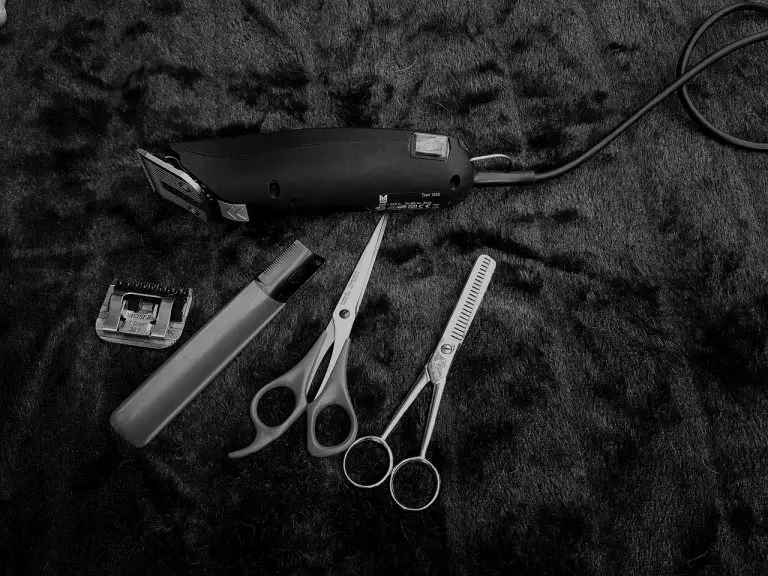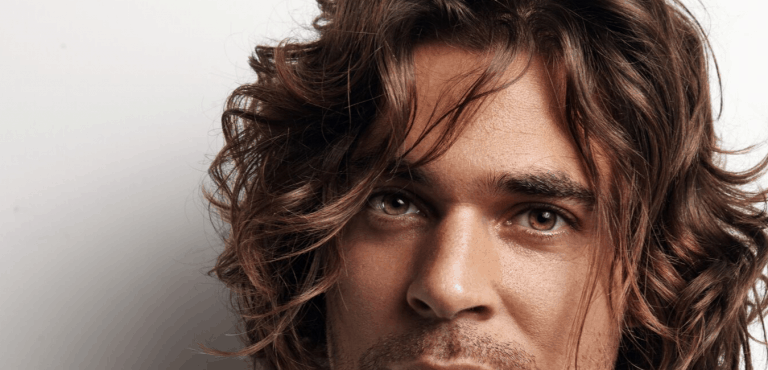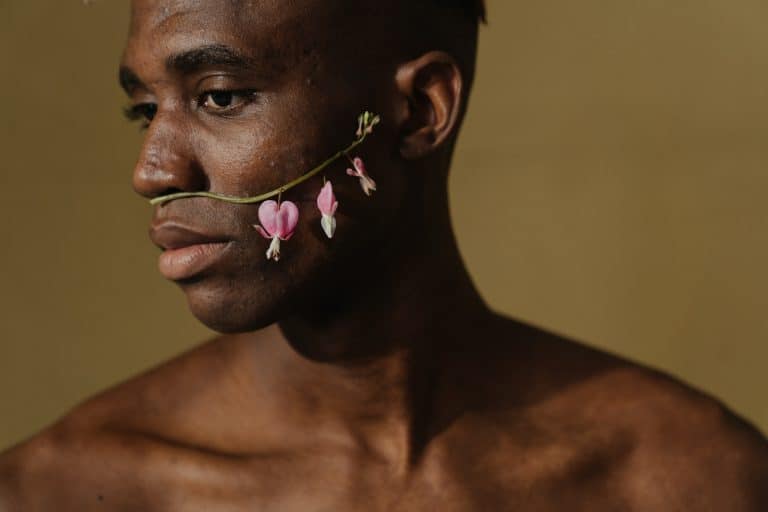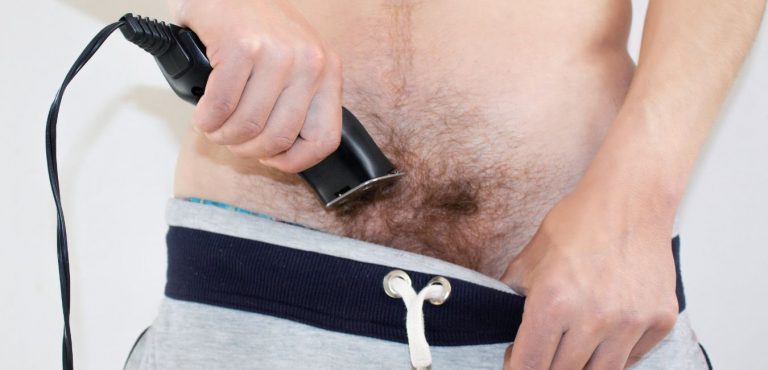Tips To Help Men Handle Thinning Hair
For millions of men, hair loss means a daily struggle with self-esteem and confidence. Many men opt to cover up their thinning hair with a hat or change up their hairstyle, but that isn’t always possible as hair loss is different for everyone. The one thing that’s certain is that hair loss is genetic, so if it’s meant to be, it’s meant to be. However, that doesn’t mean you have to live with it.
There are many ways you can handle thinning hair with style; the key is to try and remain confident because your attitude can do a lot for your outward appearance. Own your look and work with it as much as possible, because one of the biggest challenges that come with thinning hair isn’t physical; it’s emotional and mental. And self-confidence is important to everyone, so finding ways to recapture it is essential.
UK Statistics
- In the UK, around 40% of men experience noticeable hair loss by the age of 35, and this figure rises to 65% by the age of 60. (source: British Association of Dermatologists)
- Male pattern baldness is the most common cause of hair loss in the UK, affecting around 6.5 million men. (source: NHS)
US Statistics
- In the US, around 50 million men experience some degree of hair loss, and this number is expected to increase by 2025. (source: American Hair Loss Association)
- Male pattern baldness affects around 95% of men with hair loss in the US. (source: Cleveland Clinic)
Relevant Studies
- A 2018 study published in the Journal of the American Academy of Dermatology found that male pattern baldness was significantly associated with increased risk of prostate cancer in African-American men. (source: PubMed)
- A 2019 study published in the Journal of Cosmetic Dermatology found that a combination of microneedling and topical minoxidil was effective in treating male pattern baldness. (source: PubMed)
- A 2021 study published in the International Journal of Trichology found that scalp micropigmentation was a safe and effective treatment option for male and female pattern hair loss. (source: PubMed)
By understanding these statistics and relevant studies, men can make informed decisions about their hair loss and seek appropriate treatment options.
Understanding Thinning Hair and Hair Loss
Thinning hair is a gradual process that happens over time. The first signs of thinning hair usually start with a receding hairline, followed by hair loss on the crown of the head. In some cases, the hair may start to thin all over the head. There are several factors that can contribute to thinning hair in men, including genetics, age, stress, and poor nutrition.
Genetics plays a significant role in hair loss, and if your father or grandfather experienced hair loss, you may be more likely to experience it too. Age is also a factor, as hair follicles can become less active as we get older. Stress can cause hair loss by triggering the production of cortisol, a hormone that can cause hair to fall out. Poor nutrition can also contribute to hair loss, as a lack of essential vitamins and minerals can affect the health of your hair.
Meso for Men shares a few of the best tips on how to cope with and handle going bald.
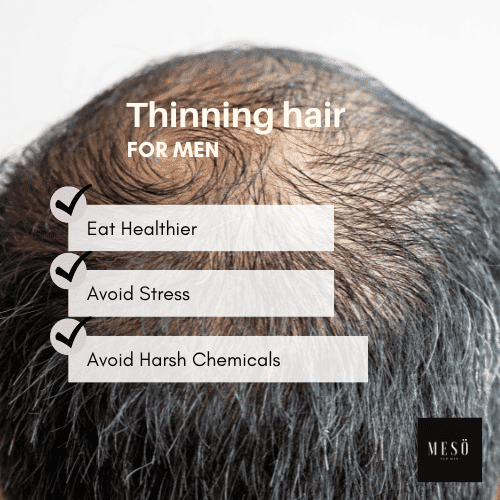
What Causes Hair Loss?
Hair loss can be caused by various factors, including genetics, hormones, medications, and underlying health conditions. The following are some of the common causes of hair loss in men:
Genetics
Male pattern baldness, also known as androgenetic alopecia, is the most common cause of hair loss in men. It is inherited from either parent and can start as early as the teenage years. Male pattern baldness affects the hair follicles, leading to shorter and thinner hair until the follicles stop producing hair.
Hormones
Hormonal imbalances can lead to hair loss in men. Testosterone is converted into dihydrotestosterone (DHT), which can damage hair follicles and cause them to shrink. This process leads to male pattern baldness.
Medications
Some medications can cause hair loss as a side effect. These medications include chemotherapy drugs, blood thinners, and antidepressants.
Underlying Health Conditions
Some underlying health conditions can cause hair loss in men. These conditions include thyroid problems, scalp infections, and autoimmune diseases.
How is Hair Loss Diagnosed?
Hair loss can be diagnosed by a dermatologist or a trichologist. The doctor will examine your scalp and hair and ask about your medical history and family history. They may also perform a scalp biopsy or blood tests to determine the underlying cause of hair loss.
Can Hair Loss be Prevented?
Hair loss can be prevented or slowed down by taking good care of your hair and scalp. The following are some tips to prevent hair loss in men:
Eat a Healthy Diet
A balanced diet rich in vitamins and minerals can promote hair growth and prevent hair loss. Foods rich in vitamin B, iron, zinc, and omega-3 fatty acids can strengthen hair follicles and improve hair health.
Avoid Harsh Chemicals
Using harsh chemicals on your hair, such as hair dyes and straighteners, can damage your hair and lead to hair loss. Avoid using these products frequently or switch to natural alternatives.
Protect Your Hair from the Sun
Exposure to the sun can damage your hair and scalp, leading to hair loss. Wear a hat or use a sunscreen spray to protect your hair and scalp from the harmful effects of the sun.
Manage Stress
Stress can trigger hair loss in men. Practice stress management techniques such as meditation, yoga, or deep breathing to reduce stress and promote hair growth.
How is Hair Loss Treated?
Hair loss can be treated by various methods, depending on the underlying cause and severity of hair loss. The following are some common hair loss treatments for men:
Medications
Some medications can slow down hair loss and promote hair growth in men. These medications include finasteride and minoxidil.
Talk To Your Doctor
If you’re interested in regrowing hair, talk to your doctor about medicated shampoo and other treatments that can help promote growth. There’s also the option of oral medication that will help you keep the hair you have and stop further loss.
Consider a Transplant
Ape To Gentleman explains that a hair transplant involves surgically placing new hair follicles into areas of the scalp that have stopped hair growth, and it’s a permanent solution that can be very natural looking. As with any surgical procedure, however, there are some pros and cons to a transplant. The pain is manageable for most patients, but you will likely be required to wear a head wrap for at least the first day after surgery and it will be important not to comb or brush your hair, as you might accidentally pull out stitches. This means you might have to take some time off work.
On the other hand, there have been many success stories from men who have undergone the procedure with great results. If you’re unsure about whether it’s right for you, talk to your doctor.
Change Your Hairstyle
The way you style your hair can do wonders for your appearance, so really take stock of whether or not your current style is working for you. Many men try the comb-over in order to hide hair loss, but the longer your remaining hair is, the worse it can look. Cut your hair short or consider shaving it all together and adding a rockin’ beard!
Here are the top 10 hairstyles for men with thinning hair:
1. Buzz Cut
The buzz cut is a classic hairstyle for men with thinning hair. It’s a low-maintenance style that requires no styling and can help create the illusion of thicker hair.
2. Crew Cut
Similar to the buzz cut, the crew cut is a short and low-maintenance hairstyle that works well for men with thinning hair. It’s a versatile style that can be adapted to different face shapes and hair types.
3. Side Part
The side part is a classic hairstyle that can work well for men with thinning hair. By sweeping the hair to one side, it can help create the illusion of volume and thickness.
4. Comb Over
The comb over is a popular hairstyle that involves combing the hair to one side and creating a part. It can be styled in different ways to suit different face shapes and hair types.
5. Short Caesar Cut
The short Caesar cut is a stylish and low-maintenance hairstyle that is great for men with thinning hair. It involves cutting the hair short and adding a fringe to the front.
6. Textured Crop
The textured crop is a modern and trendy hairstyle that works well for men with thinning hair. It involves cutting the hair short and adding texture to create the illusion of volume.
7. French Crop
The French crop is a stylish and sophisticated hairstyle that can work well for men with thinning hair. It involves cutting the hair short and adding texture to the top to create volume.
8. Slick Back
The slick back is a timeless hairstyle that can work well for men with thinning hair. It involves combing the hair back and using a styling product to keep it in place.
9. Faux Hawk
The faux hawk is a bold and edgy hairstyle that can work well for men with thinning hair. It involves cutting the hair short on the sides and adding volume to the top.
10. Bald Head
For men who are experiencing significant hair loss, the bald head can be a confident and stylish hairstyle. It’s a low-maintenance style that can be embraced with pride.
By choosing one of these top 10 hairstyles, men with thinning hair can feel confident and stylish, while also working with their hair loss rather than against it.
Practice Self-Care
Coping with hair loss can be damaging emotionally and mentally, so it’s important to do everything you can to boost your self-esteem. Practicing self-care is a great way to build confidence, which can include anything from exercising everyday to eating right and engaging in a hobby you enjoy to reduce stress. In fact, Verywell Mind points out that your stress level is an important part of making sure you’re able to reduce hair loss, so do all you can to relax and stay that way.
This includes creating a positive atmosphere in your home by removing any source of stress, such as clutter. Take some time to declutter your living space, and even incorporate a few houseplants to invite Mother Nature in.
Remember that losing your hair is not a sign of aging; it can happen to men as young as 21. It’s all about genetics and, in some cases, lifestyle.
Educate Yourself
Do some research on pattern baldness and what causes hair loss. The best way to fight something is to learn all you can about it.
Remember that losing your hair doesn’t have to mean losing your identity or your social life. Find a way to treat or cope with the loss that is right for you, and talk to your doctor before beginning any new treatment or routine. Open up to friends and family when you feel you need support, especially if you feel that these changes are affecting your mental health.
Conclusion
We hope that you can learn to handle thinning hair, using the tips above. As you can see from the statistics, it’s a very common condition for many men, so don’t feel it’s just you.
If you have been able to deal with your condition, let us know what worked for you in the comments below.
FAQs
Q1: Is hair loss in men genetic?
A1: Yes, male pattern baldness is inherited from either parent and is the most common cause of hair loss in men.
Q2: Can stress cause hair loss in men?
A2: Yes, stress can trigger hair loss in men by affecting the hair growth cycle.
Q3: Are there any natural remedies for hair loss in men?
A3: Some natural remedies, such as onion juice, aloe vera, and coconut oil, may promote hair growth and prevent hair loss.
Q4: How long does it take for hair to grow back after hair transplantation?
A4: It may take several months for the transplanted hair to grow back, and multiple sessions may be required.

